You are reading the older HTML site
Positive Feedback ISSUE
14
july/august 2004
edge electronics
G4 amplifier and G1 preamplifier
as reviewed by Victor Chavira, Jim Grudzien, and Larry Cox
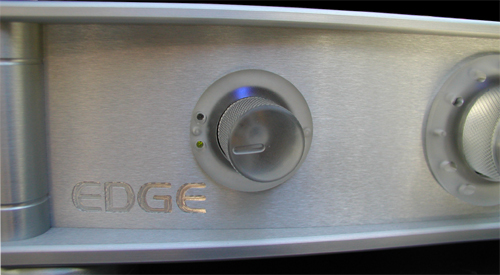
Photographs and processing by Dave Clark
|
VICTOR CHAVIRA'S SYSTEM: LOUDSPEAKERS ELECTRONICS SOURCE CABLES ACCESSORIES
|
 Edge
Electronics is a south Florida firm that has made an impact on the audio world
by utilizing lasers in the bias circuits of their most expensive amplifiers.
Edge's ultra-high-end amps are widely praised for their low distortion,
transparency, and effortless power. Looking like prop pieces from an early
Star Trek episode, the G series is Edge's trickle-down theory for listeners
of more modest means. The G1 is a line stage with remote control that retails
for $2795, and the G4 is a stereo amp that retails for $3250. I reviewed the two
pieces together, in place of my Magnum Dynalab 208 receiver. The G1 and G4 were
stacked one atop the other and linked with a meter of Soundstring interconnect.
Edge
Electronics is a south Florida firm that has made an impact on the audio world
by utilizing lasers in the bias circuits of their most expensive amplifiers.
Edge's ultra-high-end amps are widely praised for their low distortion,
transparency, and effortless power. Looking like prop pieces from an early
Star Trek episode, the G series is Edge's trickle-down theory for listeners
of more modest means. The G1 is a line stage with remote control that retails
for $2795, and the G4 is a stereo amp that retails for $3250. I reviewed the two
pieces together, in place of my Magnum Dynalab 208 receiver. The G1 and G4 were
stacked one atop the other and linked with a meter of Soundstring interconnect.
Tom Maker is the man behind the curtain at Edge. He is a designer with a keen mind and a clear aesthetic. His principal motif is a near obsessive use of machined aluminum. Every Edge product is encased in a heavy-gauge brushed aluminum chassis that effectively seals its sensitive circuits from noise and airborne vibration. The G series features high-quality circuit boards and parts throughout. The G1's three translucent knobs illuminate with an appealing violet-blue light.
"My life is like a stroll upon the beach/As near the ocean's edge as I can go." Henry David Thoreau
The first thing that impressed me about the G1/G4 combo was its intense power and responsiveness. This may have been a result of the G1's sensitive gain stage. I normally listen to music at 12 o'clock, but with the G1 I never advanced the volume beyond 9 o'clock. As a result, even though the MD 208 and the G4 are both rated at 100 watts, the Edge sounded much more powerful. Fortissimos bounded from the speakers with captivating speed and authority, and the G4 seemed to possess endless dynamic reserves.
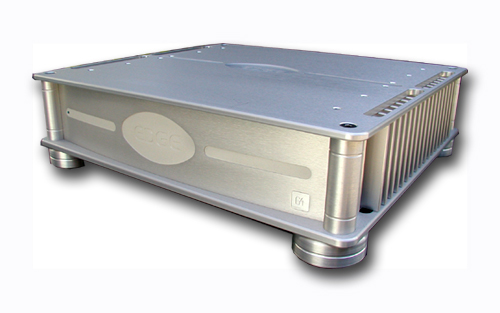
One of the first CDs I listened to was Epics, by Erich Kunzel and the Cincinnati Pops Orchestra, on Telarc. The music sounded absolutely huge. The low end was particularly impressive. My two-way Marten Monks produce bass down to 41Hz, but the bass sounded even lower due to the G4's low-frequency control. The sound was clear and deep, like a long stretch of coral-reef water. The G1/G4 combo was excellent at rendering the complex colors, shapes, and textures of an orchestra. Although these units are solid state, they did not impose a sterile sound upon the music. The orchestra sounded alive and airy, as if the performance were recorded under full house lights. The same music assumed a darker perspective when I listened to it through the ‘208, as if the orchestra were performing under slightly dimmed lights.
The G1/G4's midrange performance was exceptional in its transparency and rendition of detail. Supertramp's 1979 Breakfast in America LP isn't an audiophile classic, but it is well recorded and contains plenty of good music. Midrange instruments like guitar and keyboards had greater definition and speed. Vocals had more cohesion and lyrics had improved clarity. The noise floor lowered, and notes decayed into a deeper background. Though the company is named Edge, the G1/G4 pair did not sound edgy or aggressive. I found myself able to listen to music for hours on end, and the only fatigue I experienced came from sitting in the same position for too long. My mental image of an edge has the incisive quality of a razor or sharp knife, but that is not an accurate metaphor for the sound of the G1/ G4. Rather, think of the edge of a fine Hermes scarf or of Miles Davis' muted musings at the very edge of a microphone.
The G1/G4 also served as the center of my two-channel home theater system, and performed commendably in this role. The DVD Frida, starring the lovely Salma Hayek, is an excellent melding of visual art and music. The G1/G4 combo produced dialogue that was coherent and responsive to the actors' dramatic nuances. The music that accompanied the puppet scene was quite dynamic—strenuously strummed guitars and percussion drew me into the nightmare of Frida Kahlo's many painful post-accident operations. The Edge units' exemplary dynamic responsiveness literally had me on the edge of my seat.
One of my favorite CDs is by one of Florida's most famous residents, Gloria Estefan. Her Mi Tierra, from 1993, is a sampler of Cuban musical styles. The slow bolero, "Con Los Años Que Me Quedan" (With the Years That I Have Left), is a minimally processed ballad that glows with emotion. Estefan possesses a fine pop voice, and she is in top form on this recording. The G1/G4 combo effectively communicated the warmth and emotion of this tender song.
The Edge G1 preamp and G4 amplifier are clear contenders for being at or near the top of their classes. They may look like they came from outer space, but their sound is decidedly down to earth. The G1 and G4 sound best together. The combination delivered generous amounts of transparent power, and captured fine details and harmonic shadings without sounding too forward. Anyone who is considering components in this price range and who appreciates retro-future styling should audition these products from the "edge." Victor Chavira
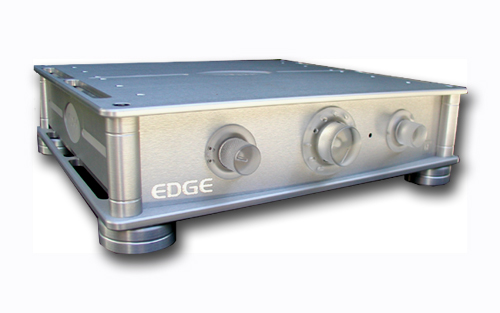
|
JIM GRUDZIEN'S SYSTEM LOUDSPEAKERS ELECTRONICS SOURCE CABLES ACCESSORIES
|
 I'm
not sure whether or not I heard the Edge components at CES this past January or
not, even though I had the company's name circled in my notes from the show. The
subjects of this review are part of Edge's new, slimline "G" series, which
includes five power amps, two preamps, and an integrated amp. The G1 preamp
boasts a frequency response of 5-300,000 Hz, a distortion of 0.009%, and an
output impedance of 50 ohms. On the back are five RCA inputs, one output, and a
tape monitor input. It comes with a remote that only controls volume. On the
front are three dials, for volume, on/mute, and source selection, illuminated in
a very cool blue. The G1 is 15 inches deep, 16 3/4 inches wide, and 4 3/8 inches
high, weighs 30 pounds, and has a brushed aluminum finish. The two-channel G4
power amp, rated at 100 watts into 8 ohms, is the same size as the preamp and
has the same finish, but weighs seven more pounds. Both components are built
like tanks, and are made in the U.S.
I'm
not sure whether or not I heard the Edge components at CES this past January or
not, even though I had the company's name circled in my notes from the show. The
subjects of this review are part of Edge's new, slimline "G" series, which
includes five power amps, two preamps, and an integrated amp. The G1 preamp
boasts a frequency response of 5-300,000 Hz, a distortion of 0.009%, and an
output impedance of 50 ohms. On the back are five RCA inputs, one output, and a
tape monitor input. It comes with a remote that only controls volume. On the
front are three dials, for volume, on/mute, and source selection, illuminated in
a very cool blue. The G1 is 15 inches deep, 16 3/4 inches wide, and 4 3/8 inches
high, weighs 30 pounds, and has a brushed aluminum finish. The two-channel G4
power amp, rated at 100 watts into 8 ohms, is the same size as the preamp and
has the same finish, but weighs seven more pounds. Both components are built
like tanks, and are made in the U.S.
Upon hooking up these components, I heard very clean, dynamic sound, and a substantial amount of power. Everyone talks about system matching and synergy, and I couldn't agree more about their importance. The Edge G1 and G4 matched very well with my Dali Grands and Arcam 72T CD player, both of which are somewhat warm and soft sounding. The Edge components took my system to new heights of performance. They dramatically closed the gap between my Dali Grands and the Dali MS4s, which cost $4000 more. While the MS4s were still slightly better, the Grands were more appropriate matches for the Edge gear. The clean, concise, and fast qualities of the G1 and G4 were already possessed by the MS4s, but were less evident with the Grands.
It was only after playing amp roulette for a few days, shuffling one in and another out, that I realized how good the Edge gear was. It was WAY more detailed, articulate, smooth, clean, and fast. Music seemed to be propelled out of my speakers. The bass was deep, solid, full, and fast. The midrange was very detailed, yet smooth and satisfying. The highs presented some challenges. With some recordings, the sound was too bright and "crispy" for my liking, but this was the exception rather than the rule. For the most part, the Edge gear reproduced the highs accurately and without problem. The recordings in question sound bright with a lot of equipment, and the Edge products' performance never reduced my musical enjoyment. For me, these characteristics, especially the mids and bass, made listening that much easier and more relaxed. I just sat back into my listening chair and let the music envelope me. These amps continually surprised me, making old recordings sound much better than previously experienced. It was like listening for the first time to many of my CD's, each disc being a new, wonderful experience.
Stevie Ray Vaughan's version of "Tin Pan Alley" on Couldn't Stand the Weather provided me with a rocking good time. His guitar had a slightly sweet sound, not tubey or soft, but in your face, firm, and precise. It was more the real thing than a recording. It was more like sitting in a club than in a recording studio, experiencing a performance rather than a recording. The cymbals were simply remarkable, the most lifelike I've heard. After the initial striking of the cymbals the decay seemed to last on and on. Tommy Shannon's bass playing was deep and powerful. I just love a good bass and this recording only confirmed those feelings to me. I could feel the notes pulsating through my chest—whew!!!
Israel Kamakawiwo‘ole's Facing Future CD is another favorite, and a good test of the upper ranges. Some of the things I listen for with this recording is IZ's voice clarity, control, and the weight he puts behind the music. I've got to feel the music here. Iz' voice can be somewhat crispy and dare I say "edgy" at the top of his vocal range. Though I cringed during a couple of his crescendos, the effect was not as bad as I've heard with some components. The presentation was weighty, clear, precise, and at the same time very natural and relaxed, with nothing forced or strained. This could be due to the musical power of the EDGE's 100 watts. Some of the delicacy of this recording was missing, but it was replaced by weight and power, which are some of the attributes that I value when listening to music. I like music with a degree of speed and power, and the EDGE gear possessed these qualities in spades.
Fleetwood Mac was a whole lot of fun, and showed me that the Edge gear can rock too. One track that caught my attention was "Tusk'. For the first time I thought a marching band was coming into my house - with each bang on the drum; they were getting closer and closer. This was especially apparent with the volume turned up a bit higher than I normally prefer, though with the Edge gear I adding a bit more volume was quite fun! Each stroke and strum of the guitar reminded me more of someone playing for me in my room than a recording. The voices were harmonically rich and satisfying. The sheen of the cymbals made a significant contribution to a very engaging performance.
There was a lot to like about this gear. It was detailed, powerful, smooth, and fast. It had power to spare, leading me to believe that the 100-watt rating is conservative. There were a few flaws—the highs were somewhat bright with some recordings, though not enough to detract from my enjoyment of the music. One other minor bone about these pieces was that even at the lowest volume, it was just too darn loud to carry on a late night conversation with a little ambient background music. Obviously, my speakers are a touch too efficient for the combo and I'm told that this can be tweaked on the inside of the amp, though I don't have the skill to perform such surgery. While the Edge gear is not particularly sexy or emotional visually, it is unquestionably engaging aurally. It continually drew me into the music, and was an excellent match with my silky-smooth Grand loudspeakers, raising their performance to the highest level I've experienced so far.
I loved the Edge gear. So much that I considered purchasing them, but then my good sense came back to me and said, "YOU NEED A NEW ROOF ON YOUR HOUSE." So $11k later with a new roof, I'm still wanting for the Edge gear. It is at the top of my list, but it will have to wait until another day.
You may not want to use the Edge G1 and G4 with a system that is already clean and fast, but if you match them with a softer-sounding system, I don't think you'll be disappointed, I wasn't. I thoroughly enjoyed each day I had with them. Jim Grudzien
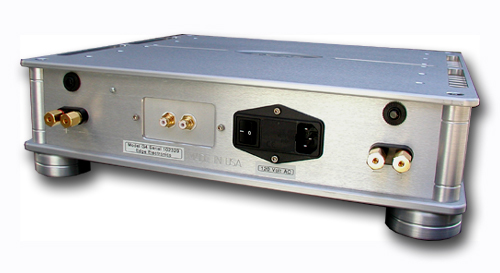
|
LARRY COX'S SYSTEM LOUDSPEAKERS ELECTRONICS SOURCE CABLES ACCESSORIES
|
 Edge
gear is nice to look at, in an industrial sort of way. While it's not a look I'd
search for, it grew on me. With its violet-colored backlighting and aluminum
fascia, it looks futuristic, like a kinder, gentler Terminator. Harry Pearson of
TAS yelped about the excellence of the more expensive siblings of the
Edge G4 amp, so I was somewhat interested, but not enough to ask for review
samples. Jim Grudzien, on the other hand, was taken by the looks of the G1
preamplifier and G4 amplifier, and asked to review them, at which point I became
more intrigued, especially because Jim had recently found himself enamored of
tube amplification. People don't usually get equally excited about both tubes
and solid state, so it seemed like the time to sit up and take notice. I
wrangled a brief visit with the G1 and the G4 and had a rather good time, so I
wanted to share my impressions.
Edge
gear is nice to look at, in an industrial sort of way. While it's not a look I'd
search for, it grew on me. With its violet-colored backlighting and aluminum
fascia, it looks futuristic, like a kinder, gentler Terminator. Harry Pearson of
TAS yelped about the excellence of the more expensive siblings of the
Edge G4 amp, so I was somewhat interested, but not enough to ask for review
samples. Jim Grudzien, on the other hand, was taken by the looks of the G1
preamplifier and G4 amplifier, and asked to review them, at which point I became
more intrigued, especially because Jim had recently found himself enamored of
tube amplification. People don't usually get equally excited about both tubes
and solid state, so it seemed like the time to sit up and take notice. I
wrangled a brief visit with the G1 and the G4 and had a rather good time, so I
wanted to share my impressions.
I won't go into the details of the units' construction, design, etc., as I am sure that Vicotr and Jim will do that. I'll go directly to describing their sound, which is much like their look—powerful, fast, and bold. They also had liquidity, but not a soft or gentle sort of liquidity. Their sound conjured up images of the liquid steel Terminator, not the one that looks like the Governor of California. There were no ragged edges to be heard, but neither was there a feather-like lightness of presentation. I heard more boldness than lightness and more speed than finesse.
The G4 sounded unusually seamless. All parts of the sonic spectrum seemed to be on the same trajectory. Bass, treble, and midrange spoke with one voice. No part of the frequency spectrum was undernourished; each had its own light and power. The bottom end was fabulous—not quite Krell-like, but more natural. Big, fast bass is fun to hear, but it seems artificial to me. With the Edge gear, the bass regions were agile and athletic. They also dug quite deep, belying the G4's "mere" 100-watt output. There was texture to the bass when appropriate, and sloppiness when the recording was sloppy.
Treble extension was good, especially for a solid state amplifier. Never hard, the treble region was, again, liquid, with strength and a slightly steely sheen that never approached hardness or wiriness. The only part of the frequency spectrum that I can criticize is the midrange. The amp was a delight at first. I heard more information in the midrange than with my reference amplifiers, which retail for nearly twice as much as the G4. On cymbal thwacks during vocals, the voices didn't drown out the cymbals or vice versa. The two had their own space, which I found quite extraordinary, but what I liked—until I didn't like it—was the slight heating up of the midrange, especially with female vocals. Because of the slightly hot upper midrange, it always seemed like the voices were in a hurry to get to a party for which they were already late.
On my reference system, Sean Colvin's Sonny Came Home sounds bright but liveable. On the Edge system, it sounded bracing, but it approached being hard to live with. The sound was not wiry, etched, or hard, just a little hot. While listening, I felt a tightness in my chest, similar to what I feel when watching the end of an exciting basketball game that my team might not win. Changing my Belden 1209A speaker cables, which can sound a little bright, to IXOS 6003s didn't change the situation much. Richer, warmer, and darker cables didn't alter the overall impression of a slightly hot midrange.
The Story's The Angel in the House is a nice CD, with female vocals that sound lightweight rather than bright, but the Edge electronics made them sound slightly hotter than my reference does, and hotter than what I think is proper. Israel Kamakawiwo‘ole's Facing Future features a nearly 800-pound singer with an angelic, almost female vocal quality, but there are parts of the recording in which Israel's voice sounds warm and breathy. The Edge gear slightly pushed his voice up in timbre. On my reference E.A.R. gear, his voice is less hot and slightly warmer. I have installed NOS tubes in my amp and preamp to warm them up, as NOS tubes are an appropriate match with my Audio Note 3.1x CD player. The 3.1x may be contributing to the midrange heat of the Edge G1/G4 combo.
It may sound like I'm hammering the Edge products, but I'm not. While they're not cheap at $2795 for the preamp and $3250 for the amp, they offer very good performance for the money. Don't forget: No amplifier has ever made a sound without a speaker or a source component hooked to it. You are creating a system, not a Frankenstein compilation of parts. Everything has to work together. In my system, the Edge amp and preamp were a little too bracing to be satisfying for the long term, but they were enjoyable. In another, sleepier system, the Edge G1 and G4 could provide missing drive. Match them with a more laid-back speaker and CD player, and you could be in the catbird seat.
Jim Grudzien's Arcam CD player has a much more laid back, relaxed presentation than my Audio Note. His Dali Grands are also more laid back than my ATC SCM 35s, so my bet is that the G1 and G4 sounded quite nice in his system. The G1 and G4 will match well with lots of forgiving, richer-sounding speakers. One brand that comes to mind is PSB. Another is Vandersteen, at least their entry-level models. With the caveat that you must match your other components carefully, I find the Edge G1 and G4 recommendable. Larry Cox
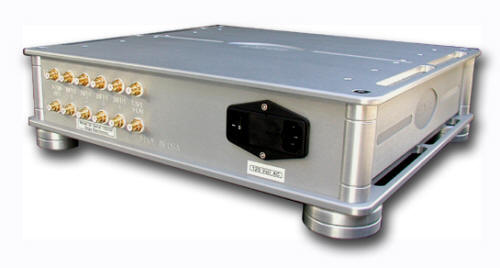
Edge G1 preamplifier
Retail: $2795
Edge G4 amplifier
Retail: $3250
Edge Electronics
web address: www.edgeamp.com
